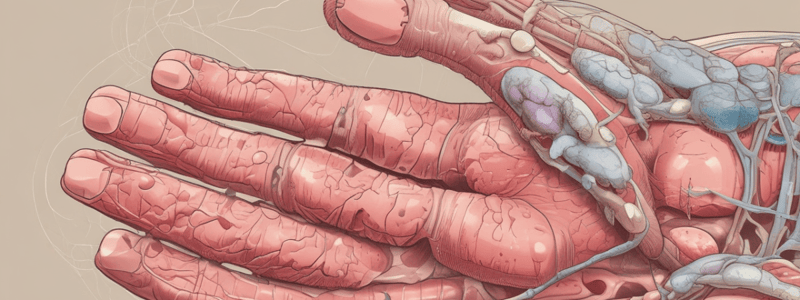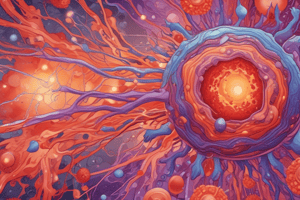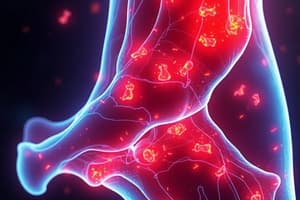Podcast
Questions and Answers
What is the primary function of uricosuric drugs in the long-term control of gout?
What is the primary function of uricosuric drugs in the long-term control of gout?
- Increasing uric acid excretion (correct)
- Relieving pain and inflammation
- Inhibiting xanthine oxidase
- Inhibiting prostaglandin secretion
What is the mechanism of action of colchicine in treating acute gout attacks?
What is the mechanism of action of colchicine in treating acute gout attacks?
- Inhibiting microtubule formation (correct)
- Inhibiting osteoclast activation
- Inhibiting prostaglandin secretion
- Inhibiting xanthine oxidase
What is the role of osteoclasts in the progression of gout?
What is the role of osteoclasts in the progression of gout?
- Secretion of prostaglandins and cytokines
- Activation of immune cells
- Inflammation of joints
- Demineralisation of bone (correct)
What is the primary metabolite of hypoxanthine in the uric acid pathway?
What is the primary metabolite of hypoxanthine in the uric acid pathway?
What is the mechanism of action of allopurinol in the long-term control of gout?
What is the mechanism of action of allopurinol in the long-term control of gout?
What is the primary function of non-steroidal anti-inflammatory drugs (NSAIDs) in the treatment of acute gout attacks?
What is the primary function of non-steroidal anti-inflammatory drugs (NSAIDs) in the treatment of acute gout attacks?
Xanthine oxidase is an enzyme that converts xanthine to uric acid in the uric acid pathway.
Xanthine oxidase is an enzyme that converts xanthine to uric acid in the uric acid pathway.
Probenecid is a xanthine oxidase inhibitor used in the long-term control of gout.
Probenecid is a xanthine oxidase inhibitor used in the long-term control of gout.
Cytokines are a type of lipid mediator involved in the resolution of inflammation.
Cytokines are a type of lipid mediator involved in the resolution of inflammation.
Aspirin is a non-steroidal anti-inflammatory drug (NSAID) that is commonly used to treat acute gout attacks.
Aspirin is a non-steroidal anti-inflammatory drug (NSAID) that is commonly used to treat acute gout attacks.
Hypoxanthine is converted to xanthine in the uric acid pathway.
Hypoxanthine is converted to xanthine in the uric acid pathway.
The activation of osteoclasts leads to the demineralization of bones.
The activation of osteoclasts leads to the demineralization of bones.
Flashcards are hidden until you start studying
Study Notes
Gout and Inflammation
- Gout is a condition characterized by the recruitment of immune cells, secretion of prostaglandins and cytokines, and activation of osteoclasts, leading to demineralisation.
- The progression of gout involves the recruitment of immune cells, secretion of prostaglandins and cytokines, and activation of osteoclasts, leading to demineralisation.
Biochemistry of Gout
- Hypoxanthine is converted to xanthine, and then to uric acid.
- Allopurinol is a xanthine oxidase inhibitor that prevents the conversion of xanthine to uric acid.
Treatment of Gout
- Acute attacks of gout are treated with NSAIDs (except aspirin) and colchicine, a microtubule inhibitor.
- Long-term control of gout is achieved with uricosuric drugs, such as probenecid, which increase uric acid excretion, and allopurinol, which inhibits xanthine oxidase.
Studying That Suits You
Use AI to generate personalized quizzes and flashcards to suit your learning preferences.




